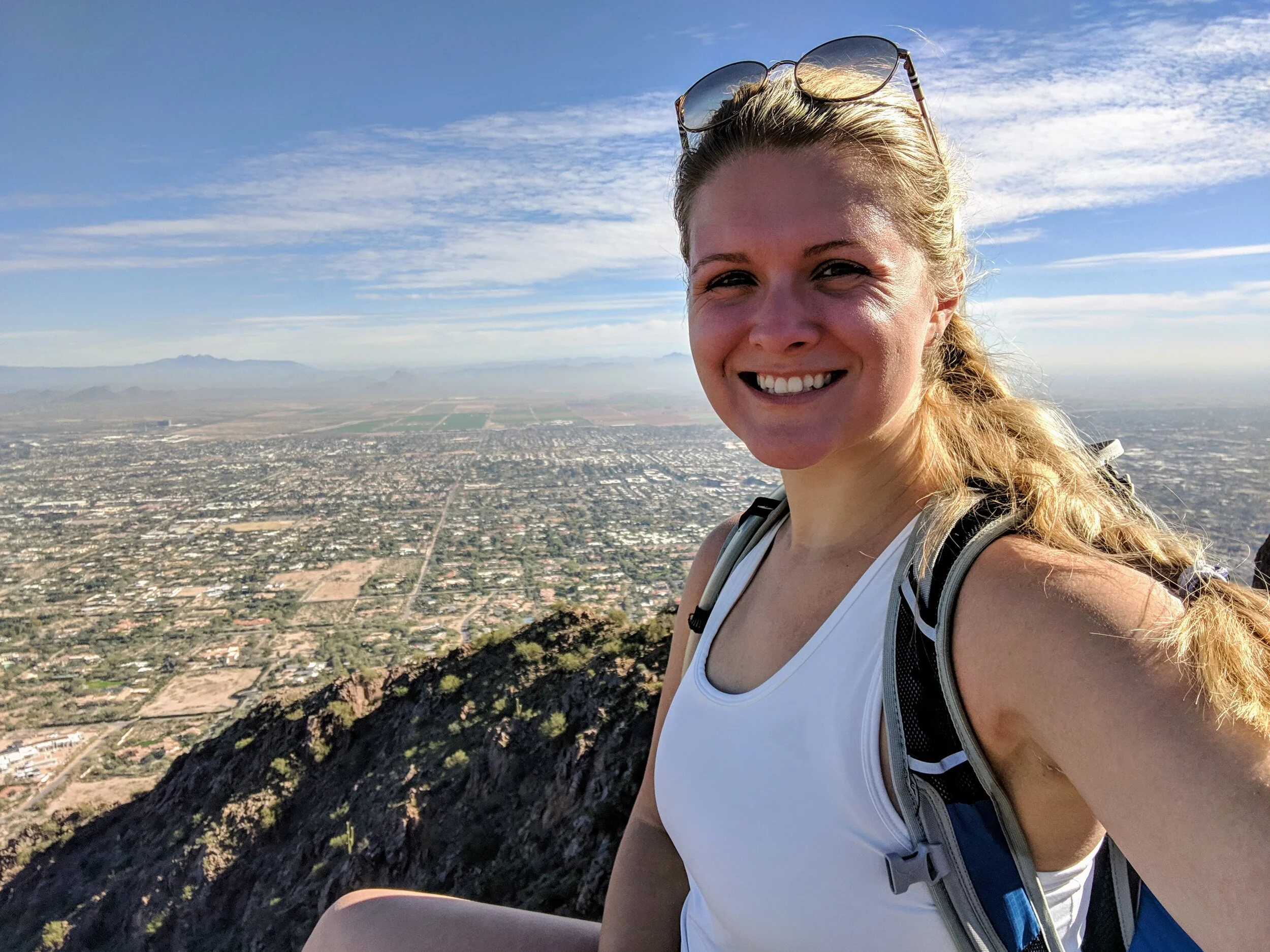It's Good to Be Alone
by Sarah Pratt
My favorite pastime is hiking. While I love hiking with friends or family, they aren’t always available to join me, and in some ways I prefer hiking by myself. Over the years I have developed some habits to improve my safety when I set out on my own.
Camelback Mountain, Phoenix, AZ
Here is a list of my personal tips*. Many of these items apply to group hiking as well, but as a solo hiker I add extra precautions.
Angels Landing, Zion National Park, UT
Before setting out, do your research. Study the trail and map and read reviews. Also, be sure to check the weather forecast.
Download GPS driving directions on your phone. If you lose service, you can still find your trailhead.
For longer hikes, be prepared to spend the night. Have an emergency blanket, a down jacket, and a rain jacket because you never know. Keep in mind that when you are hiking by yourself your pack might be heavier. Mine is usually about 25 pounds when hiking alone (mostly due to water), but a lot less than that when with someone else. Plan accordingly and consider the extra weight when choosing the trail and terrain. Standard gear that you should always include in your pack is a first aid kit, flashlight, headlamp, dry bags, toilet paper, a small shovel or trowel, and storage for garbage (leave no trace). There are many great online lists to guide you in packing.
In addition to standard gear, when I hike alone, I carry extra food and water. I like to bring a bottle of insulated water along with a full water bladder in my day pack. I never drink all of it, but it is better to have more than less. There have been multiple times where I have been hiking and seen someone out of water or dehydrated on the trail. Since I bring extra water, I am always able to share. I also put a bottle of insulated water in the car for after my hike, which stays extra cold. In addition, I carry a water filtration system with me. I have had the MSR MiniWorks EX Water Filter for several years and it still works great.
Always wear high quality, supportive hiking shoes with traction and take good care of them off the trail. Wear good socks too. I carry a bottle of liquid bandage in my pack just in case I need to treat a blister. After I am done hiking, there is nothing I want more than to take off my shoes, so I always leave a pair of sandals in the car to change into.
Bring your trekking poles. I hardly ever actually use my trekking poles, but I always bring them with me solo hiking. If I’m in an area where there might be animals that need warning I am coming, I pull out my trekking poles because they can make a decent amount of noise. Also, it is my only weapon-like object I carry. You never know when they might come in handy.
Bring a satellite phone and get a texting plan. I use the Garmin inReach Mini. It might be overkill, but if something ever happens to me I want to know that I was as prepared as possible.
Share your location with someone, whether it is on your cell phone or satellite phone. You can even stop by the ranger station and record your hike if you choose.
Tell someone where you are going and what time you expect to be done. I always estimate 30 minutes per mile – that is an overestimate but gives me wiggle room to go off and explore other trails or talk to people without having anyone worry.
Don’t post on social media until you are home. I don’t advertise where I go even when I am with other people.
It is especially important to be aware of your surroundings. Put your phone away and keep your hands free while on the move.
Remember you don’t have to make small talk with other people if you don’t want to or feel uncomfortable. For extra safety, I hardly ever admit I am alone. If someone asks, I either tell them my husband is a little bit behind me because he stepped off the trail for a minute, or I point to a group nearby and say, “I'm with them.”
It is always safest to hike in groups, but with some extra precautions you can have a great solo hike. Always remember safety is your first priority.
Saddle Pass, Badlands National Park, SD
*Please use this as a guide only. All forms of outdoor recreation have a higher level of risk than most ordinary activities and can be potentially hazardous and/or dangerous. This includes hiking and especially off trail adventure hiking, which I do not recommend as a solo activity. Weather can be unpredictable and unforeseen events can create hazardous conditions. There are many risks, both natural and/or man-made, that can lead to injury or death while hiking. It is the responsibility of the individual to learn the necessary skills for safe hiking. All participants must assume responsibility for their own actions and safety, exercise sound judgment, be prepared for all conditions, and seek advice on current weather and trail conditions. Conditions can change from day to day or season to season. Health experts suggest you always consult a physician before starting a new exercise program or physical activity.
My mom’s disclaimer: “Don’t do it. Always hike in pairs or groups!”
Somewhere near Palm Desert, CA



